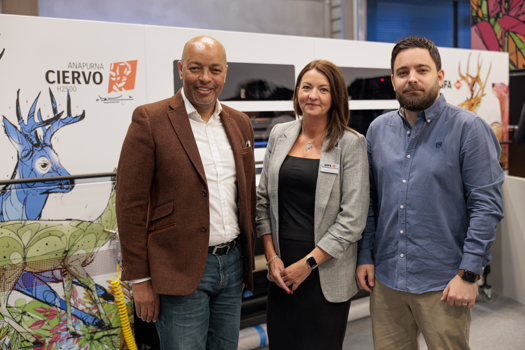What do you feel were the main trends and key industry developments in 2023?
I have seen three main trends; inkjet, automation and, more recently, carbon efficiency.
In inkjet the major suppliers are now champing at the bit to roll out their new presses and start the migration from litho over to digital as the cost per page starts to become more viable. Energy costs aren’t helping this of course where drying is key to the inkjet process and that volatility probably needs to settle somewhat.
Automation is now the norm for companies as they go further online for their business. Making your company available 24 hours a day for quotes and product orders is essential. Having an automated tracking and workflow system to produce this is equally as important and reduces numerous touchpoints along the way. With the right system in place a printer can keep an eye on their profit margins at any time and from anywhere in the world. It presents the leanest method of manufacturing to customers and speeds up the decision-making process.
Carbon efficiency is something that will engulf all of us at some point and should not be ignored. Some of the largest companies in the world who place millions of pounds worth of print and packaging are all starting to issue carbon statements to suppliers. Companies such as Coca-Cola, Kellogg's, Procter & Gamble and Tesco have done so already. These demands will get pushed back down through their supply chains and if you want to work with them, you will be required to know the carbon footprint of the work you are producing. A system like PrintIQ does this now and is becoming a recognised source for offering this at the early quotation stage of a job.
How have the continuing economic and market specific challenges affected you and your customers during 2023 – have you had to do anything differently to adapt/react?
Businesses were still feeling the aftershocks of Covid and Brexit during 2023 and those shocks have impacted them in many ways. We have seen companies ‘hunkering’ down with costs and looking to be more efficient with automation and new revenue streams.
I think it’s fair to say that if you haven’t got automation and an efficient MIS system in place you are exposing your business further as utility and consumables bill volatility continues to shake industries worldwide.
As customers start to turn an eye towards inkjet and digital presses, they realise that the print process is a complete ecosystem driven by many elements and to remain competitive they now, more than ever need to keep an eye on their margins.
The skill shortage within the industry complicates issues and at PrintIQ we have consciously made the system incredibly easy for non-skilled staff to use so that companies can eliminate errors and touchpoints along the way.
What do you expect to be the main trends, key industry developments, and biggest opportunities for printers in 2024?
The transition to sheetfed inkjet will be playing on many manufacturers' minds as their machines become more mature and more affordable. Turning plates into clicks is a trend that will be testing everyone. A digital online presence will be essential for companies to continue to grow and introduce new revenue streams.
I think there will be more acquisitions and amalgamations of companies in the print sector although the overall print volumes will continue to grow as it has once again become a major B2C staple with so much digital advertising noise around. Expect a major push towards carbon efficiency and displaying your credentials.
Packaging, wide-format and signage still offer huge opportunities as does textiles and fashion printing with the advent of very lucrative brand licensing driving a major revenue stream for brand owners. This is a relatively new trend but take any well-known children’s character old or new and license the character to be printed on t-shirts, socks, lunchboxes, etc, and it will double or triple a product's saleability.
Are you exhibiting at Drupa 2024? If so, what are your hopes and expectations for the show?
PrintIQ will be on a partner stand for Drupa as this is where we are more efficient at such a large show. I think you must manage your expectations with any show as people do so much research online these days, that said Drupa has always delivered and is a great technology showcase.
AI has been one of the hot topics of 2023 – what opportunities and threats do you think it poses for print in 2024 and beyond?
I remember people being scared of the internet when it first emerged as is a lot of new technology, but I think you should embrace it and control it. From a customer service point of view, I think it will be incredibly useful to engage new business and help people place print orders. It will probably adapt itself to the design workspace very well and deliver digital images never seen before.
As a software supplier it will be interesting to see if it can learn coding and speed up integrations but, again, I see it as helping customer-facing issues rather than the backend.
How can suppliers better help printers navigate the challenges and seize the opportunities in 2024?
Transparency and good quality information is essential when you are a potential customer and having suppliers understand your business challenges and helping them adapt are also critical elements. Localised events with collaborative partners really do seem to be favoured by customers who can come along for a few hours and get the most out of first-hand discussions.
There needs to be more focus as an industry on apprenticeships to recruit a younger audience into the workplace and show the variety of skills that can be used from software programmers to graphic designers.
Note: This prediction is taken from a special Briefing article in the new issue of Printweek featuring insights from industry suppliers, hence it does not follow the same question template as the other predictions.










